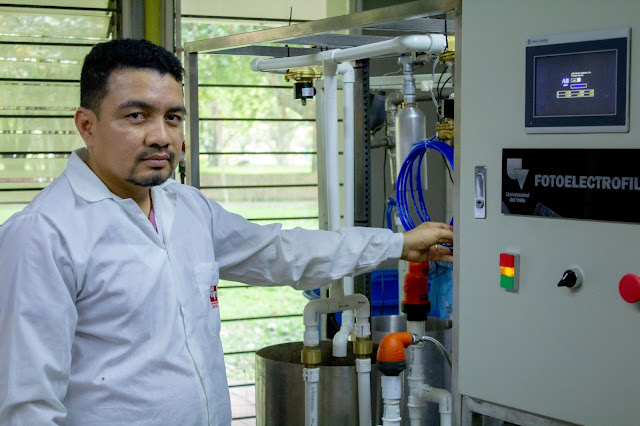Drinking water supply and renewable forms of energy are among the biggest challenges facing the world today - but now there is a machine that can solve both problems at the same time.
At the School of Chemical Engineering of the Universidad del Valle (Univalle), there is a working prototype of a machine that uses photo-electrochemical reactions to degrade contaminants in water and capture the hydrogen and oxygen produced during the process.
Dr. José Antonio Lara Ramos, a doctoral graduate from the School of Chemical Engineering and current researcher of the Research Group of Advanced Oxidation Processes for Biological and Chemical Treatment (GAOX), in a sustainable aquaculture agro-production project with community integration through the execution of the international biotechnological patent license sponsored by Minciencias and in association with BHI SAS.
Dr. Lara explained that during the development of a process to treat wastewater, he realized that this hydrogen could be captured and used to generate electricity.
The size of the global market for green hydrogen (hydrogen generated from renewable sources) was valued at $4.02 billion in 2022, according to a market report published in 2023.
"In this reaction, hydrogen is a high value-added byproduct," Dr. Lara said.
Photo: José Antonio Lara Ramos showed the prototype controls. Credit: Alexander Bejarano/NCC-FI/Univalle
The Research
Typically, in the treatment of contaminated water by advanced oxidation processes, catalysts are used to increase the rate of a chemical reaction (without consuming the catalyst in the process).
In this case, a photosensitive electrode transforms water; electrical energy; and ultraviolet radiation into molecules of hydrogen, oxygen and hydroxyl radicals.
Hydroxyl radicals are quite unstable molecules that damage other chemical structures, specifically organic contaminants that are not degraded by other treatment methods.
"The design and construction of a device that does not exist in the market always involves challenges for a work team and with the Fotoelectro Filtro-H2 many technical and scientific aspects from different disciplines come together that turn out to be critical," Dr. Diaz said.
Professor Machuca explained that this process is currently under patent application before the Colombian Superintendence of Industry and Commerce under file No. NC2022/0016422.
"This prototype constitutes an advance of the Faculty of Engineering in implementing solutions for wastewater treatment through advanced processes and the production of added value," Professor Machuca said.
|
Read more from Univalle’s School of Chemical Engineering: Univalle Researcher seeks to catalyze chemical reactions... and development for his Indigenous community |
Photo:Members of the Cabildo Indígena del Pueblo Zenú (CIPEZ) of Turbaco, Bolívar department of Colombia (Credit: CIPEZ).
Future ambitions
In 2006, on average only 25% of the water discharged was treated, increasing the contamination of water resources, according to a report by the Superintendencia de Servicios Públicos of Colombia.
In addition, more than three million people (7% of the Colombian population) do not have access to safe drinking water, according to a Colombian government bulletin in 2021.
For Dr. Lara, it is an issue close to his heart - he is a member of the Cabildo Indígena del Pueblo Zenú.(CIPEZ) of Turbaco, in the department of Bolivar, and maintains strong connections with this community of 1,200 people.
In the future, Dr Lara is planning to install solar panels and a treatment plant in this community to produce drinking water for people, animals and crops.
"Globally, they have focused on producing hydrogen, but it is not very common to build pilot processes that simultaneously treat water and produce hydrogen," said Dr. Lara, adding that the researchers are already in negotiations with companies to commercialize the plant with the support of the University.
"It was an idea that we had in the working group, but we are surprised by the strong interest of the industry," Dr. Lara said, adding that there are companies interested in financing plants in communities such as Turbaco, in order to earn carbon credits through green hydrogen.
In addition, Dr. Diaz said the project's contribution to the circular economy is important because the initial challenge was food security in small communities.
"It is one of the fundamental pillars on which work is being done worldwide to reduce environmental impact and create more sustainable processes," Diaz said.
If you are interested in contacting the researcher or learning more about the project, please write to the Communications Office, Faculty of Engineering: comunicaingenieria(at)correounivalle.edu.co
Cover photo: José Antonio Lara Ramos demonstrated the prototype at Univalle's Chemical Engineering School. Credit: Alexander Bejarano/NCC-FI/Univalle



Comentarios
Publicar un comentario